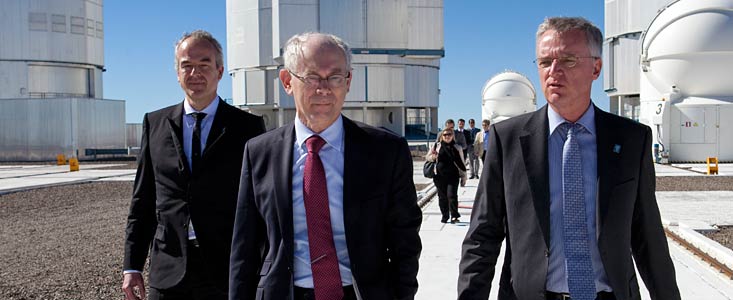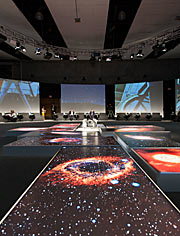Persbericht
Hoge Europese delegaties bezoeken Paranal
28 januari 2013
Na afloop van de topconferentie van de Gemeenschap van Latijns-Amerikaanse en Caraïbische Staten en de Europese Unie (CELAC-EU) hebben verscheidene hoge Europese delegaties de afgelopen dagen een bezoek gebracht aan de ESO-sterrenwacht op Paranal, in het noorden van Chili. De top, de grootste die ooit door Chili werd georganiseerd, vond in de week van 22 tot 28 januari 2013 plaats in Santiago. ESO speelde een hoofdrol bij dit evenement en greep deze gelegenheid aan om haar onderzoek en faciliteiten te presenteren aan vertegenwoordigers van de lidstaten.
In de loop van de week bezochten verscheidene Europese hoogwaardigheidsbekleders ESO-locaties in Chili. Onder hen waren: de voorzitter van de Europese Raad, Herman Van Rompuy; de voorzitter van de Europese Commissie, José Manuel Barroso; de hoge vertegenwoordiger voor Buitenlandse Zaken en Veiligheidsbeleid van de Europese Unie, Barones Catherine Ashton van Upholland; de minister van Buitenlandse Zaken van Zweden, Carl Bildt; de eurocommisaris voor Handel, Karel De Gucht; en de directeur van de afdeling Amerika’s van het Britse Foreign & Commonwealth Office, Kate Smith.
Eenenzestig staatshoofden en regeringsleiders uit Latijns Amerika, de Caraïben en de Europese Unie waren, samen met ministers en andere ambtenaren, uitgenodigd voor de top. Doel van de bijeenkomst was de vorming van een strategische alliantie voor duurzame ontwikkeling en het intensiveren van de samenwerking op het gebied van politiek, economie, wetenschap en energiebeleid.
Herman Van Rompuy en José Manuel Barroso bezochten onafhankelijk van elkaar de ESO-sterrenwacht op Paranal, die op een hoogte van 2635 meter in de Chileense Atacamawoestijn staat. Op de sterrenwacht kregen beiden een rondleiding van Tim de Zeeuw, algemeen directeur van ESO, die hen de vier 8,2-meter telescopen van de Very Large Telescope (VLT) – de meest geavanceerde optische/infraroodtelescoop ter wereld – liet zien. Ze brachten ook een bezoek aan de bekroonde Residencia, het gastenverblijf/kantoorgebouw van de Paranal-sterrenwacht.
Tijdens zijn bezoek zei Herman Van Rompuy: ‘De buitengewone telescopen hier zijn een eerbetoon aan de Europese wetenschap en industrie, maar ook aan de effectieve wijze waarop zij binnen ESO samenwerken – zowel met collega-lidstaten als met het gastland Chili. Paranal is een krachtig symbool van het menselijke streven naar kennis en van internationale samenwerking.’
José Manuel Barroso sprak zijn dankbaarheid uit over de gelegenheid om de Paranal-sterrenwacht te bezoeken: ‘Dit was een geweldige kans om deze spectaculaire plek te bezoeken en met eigen ogen de vruchten te kunnen zien van de astronomische samenwerking tussen vele Europese landen. Het is van het grootste belang dat we de grenzen van de wetenschap verkennen en onze kennis van het heelal verdiepen. Als Europeaan ben ik er trots op dat we aan dit ambitieuze doel vasthouden.’
Tim de Zeeuw voegde daar aan toe: ‘We zijn vereerd om de leiders van de Europese Unie en vertegenwoordigers van Europese landen hier op Paranal te mogen ontvangen, en ons werk aan hen te kunnen presenteren. ESO is een goed voorbeeld van hoe mensen uit vele verschillende landen en van vele culturele achtergronden kunnen samenwerken om de astronomie in onze lidstaten en het gastland Chili te laten doordringen tot de voorste gelederen van het astronomische onderzoek.’
Catherine Ashton, de hoge vertegenwoordiger voor Buitenlandse Zaken en Veiligheidsbeleid van de Europese Unie, bracht eerder in de week een bezoek aan de Paranal-sterrenwacht. Zij was in gezelschap van de Zweedse minister van Buitenlandse Zaken, Carl Bildt.
ESO’s vertegenwoordiger in Chili, Massimo Tarenghi concludeerde: ‘We zijn dankbaar voor de al lang bestaande steun van onze Europese lidstaten en voor de enorme hulp van de Chileense regering, die ons in staat stellen om hier in Chili aan geavanceerd wetenschappelijk onderzoek te doen – nu met de VLT, en straks met de European Extremely Large Telescope, het grootste oog op de hemel ter wereld.’
Daarnaast bracht Kate Smith, directeur van de afdeling Amerika’s van het Britse Foreign & Commonwealth Office, een bezoek aan het ESO-kantoor in Santiago, waar de ESO-activiteiten in Chili worden gecoördineerd.
ESO was ook uitgenodigd om tijdens de CELAC-EU-top een presentatie te geven van haar activiteiten. De sterren zelf waren vertegenwoordigd in het logo van de top, gebaseerd op het vermaarde werk van de Chileense beeldhouwer Mario Irarrázabal. De ESO-tentoonstelling Awesome Universe, samengesteld ter gelegenheid van ESO’s vijftigste verjaardag in 2012, en ESO-beelden van hemelobjecten die doorgaans alleen in het presidentiële paleis in Santiago te bewonderen zijn, vormden het decor.
Meer informatie
ESO is de belangrijkste intergouvernementele astronomische organisatie in Europa en de meest productieve sterrenwacht ter wereld. Zij wordt ondersteund door vijftien landen: België, Brazilië, Denemarken, Duitsland, Finland, Frankrijk, Italië, Nederland, Oostenrijk, Portugal, Spanje, Tsjechië, het Verenigd Koninkrijk, Zweden en Zwitserland. ESO voert een ambitieus programma uit, gericht op het ontwerpen, bouwen en beheren van grote sterrenwachten die astronomen in staat stellen om belangrijke wetenschappelijke ontdekkingen te doen. Ook speelt ESO een leidende rol bij het bevorderen en organiseren van samenwerking op astronomisch gebied. ESO beheert drie waarnemingslocaties van wereldklasse in Chili: La Silla, Paranal en Chajnantor. Op Paranal staan ESO’s Very Large Telescope (VLT), de meest geavanceerde optische sterrenwacht ter wereld, en twee surveytelescopen: VISTA werkt in het infrarood en is de grootste surveytelescoop ter wereld en de VLT Survey Telescope is de grootste telescoop die uitsluitend is ontworpen om de hemel in zichtbaar licht in kaart te brengen. ESO is ook de Europese partner van de revolutionaire telescoop ALMA, het grootste astronomische project van dit moment. Daarnaast bereidt ESO momenteel de bouw voor van de 39-meter Europese Extremely Large optical/near-infrared Telescope (E-ELT), die ‘het grootste oog op de hemel’ ter wereld zal worden.
Links
Contact
Lars Lindberg Christensen
ESO education and Public Outreach Department
Garching bei München, Germany
Tel: +49-89-3200-6761
Mobiel: +49-173-3872-621
E-mail: lars@eso.org
Massimo Tarenghi
ESO Representative in Chile
Santiago, Chile
Tel: +56 2 463 3143
E-mail: mtarengh@eso.org
Marieke Baan (Perscontact Nederland)
ESO Science Outreach Network
en NOVA Informatie Centrum
Tel: +31(0)20-5257480
E-mail: eson-netherlands@eso.org
Over dit bericht
| Persberichten nr.: | eso1305nl |
| Naam: | ESO Director General, Site visit |
| Type: | Unspecified : Technology : Observatory |
| Facility: | Very Large Telescope |
Our use of Cookies
We use cookies that are essential for accessing our websites and using our services. We also use cookies to analyse, measure and improve our websites’ performance, to enable content sharing via social media and to display media content hosted on third-party platforms.
ESO Cookies Policy
The European Organisation for Astronomical Research in the Southern Hemisphere (ESO) is the pre-eminent intergovernmental science and technology organisation in astronomy. It carries out an ambitious programme focused on the design, construction and operation of powerful ground-based observing facilities for astronomy.
This Cookies Policy is intended to provide clarity by outlining the cookies used on the ESO public websites, their functions, the options you have for controlling them, and the ways you can contact us for additional details.
What are cookies?
Cookies are small pieces of data stored on your device by websites you visit. They serve various purposes, such as remembering login credentials and preferences and enhance your browsing experience.
Categories of cookies we use
Essential cookies (always active): These cookies are strictly necessary for the proper functioning of our website. Without these cookies, the website cannot operate correctly, and certain services, such as logging in or accessing secure areas, may not be available; because they are essential for the website’s operation, they cannot be disabled.
Functional Cookies: These cookies enhance your browsing experience by enabling additional features and personalization, such as remembering your preferences and settings. While not strictly necessary for the website to function, they improve usability and convenience; these cookies are only placed if you provide your consent.
Analytics cookies: These cookies collect information about how visitors interact with our website, such as which pages are visited most often and how users navigate the site. This data helps us improve website performance, optimize content, and enhance the user experience; these cookies are only placed if you provide your consent. We use the following analytics cookies.
Matomo Cookies:
This website uses Matomo (formerly Piwik), an open source software which enables the statistical analysis of website visits. Matomo uses cookies (text files) which are saved on your computer and which allow us to analyze how you use our website. The website user information generated by the cookies will only be saved on the servers of our IT Department. We use this information to analyze www.eso.org visits and to prepare reports on website activities. These data will not be disclosed to third parties.
On behalf of ESO, Matomo will use this information for the purpose of evaluating your use of the website, compiling reports on website activity and providing other services relating to website activity and internet usage.
Matomo cookies settings:
Additional Third-party cookies on ESO websites: some of our pages display content from external providers, e.g. YouTube.
Such third-party services are outside of ESO control and may, at any time, change their terms of service, use of cookies, etc.
YouTube: Some videos on the ESO website are embedded from ESO’s official YouTube channel. We have enabled YouTube’s privacy-enhanced mode, meaning that no cookies are set unless the user actively clicks on the video to play it. Additionally, in this mode, YouTube does not store any personally identifiable cookie data for embedded video playbacks. For more details, please refer to YouTube’s embedding videos information page.
Cookies can also be classified based on the following elements.
Regarding the domain, there are:
- First-party cookies, set by the website you are currently visiting. They are stored by the same domain that you are browsing and are used to enhance your experience on that site;
- Third-party cookies, set by a domain other than the one you are currently visiting.
As for their duration, cookies can be:
- Browser-session cookies, which are deleted when the user closes the browser;
- Stored cookies, which stay on the user's device for a predetermined period of time.
How to manage cookies
Cookie settings: You can modify your cookie choices for the ESO webpages at any time by clicking on the link Cookie settings at the bottom of any page.
In your browser: If you wish to delete cookies or instruct your browser to delete or block cookies by default, please visit the help pages of your browser:
Please be aware that if you delete or decline cookies, certain functionalities of our website may be not be available and your browsing experience may be affected.
You can set most browsers to prevent any cookies being placed on your device, but you may then have to manually adjust some preferences every time you visit a site/page. And some services and functionalities may not work properly at all (e.g. profile logging-in, shop check out).
Updates to the ESO Cookies Policy
The ESO Cookies Policy may be subject to future updates, which will be made available on this page.
Additional information
For any queries related to cookies, please contact: pdprATesoDOTorg.
As ESO public webpages are managed by our Department of Communication, your questions will be dealt with the support of the said Department.





